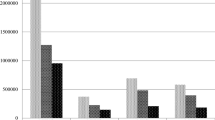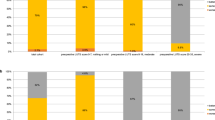Abstract
Background
Lower urinary tract symptoms (LUTS) are strongly linked with obesity. Whether bariatric surgery can effectively alleviate LUTS in morbidly obese men is unknown. The objective of the present study was to evaluate the effectiveness of bariatric surgery in reducing the prevalence and severity of male LUTS in obese patients.
Methods
This was a prospective observational study on consecutive morbidly obese men undergoing bariatric surgery. The International Prostate Symptom Score (IPSS) was used to assess for LUTS before and at 1–3 years after surgery. The 3-year changes in IPSS, the changes in LUTS severity, and the factors associated with LUTS improvement were evaluated.
Results
This study recruited 143 morbidly obese men (mean age 43.0 ± 10.4 years) undergoing sleeve gastrectomy (n = 89) and Roux-en-Y gastric bypass (n = 54). The rates of follow-up after surgery were 94.4% (n = 119/126) at 1 year, 90.6% (n = 96/106) at 2 years, and 81.2% (n = 69/85) at 3 years. After surgery, there was significant body mass index reduction from 39.1 ± 5.2 kg/m2 preoperatively to 30.1 ± 4.8 kg/m2 at 1 year and 31.5 ± 4.9 kg/m2 at 3 years (P < 0.001). There was significant reduction in IPSS total symptom score, quality of life score, frequency score, and nocturia score (P < 0.05). The prevalence of moderate to severe LUTS reduced from 35.0% (29.4% moderate; 5.6% severe) preoperatively to 21.8% (19.3% moderate; 2.5% severe) at 1 year and 30.4% (24.6% moderate; 5.8% severe) at 3 years (P < 0.001). LUTS improvement was significantly associated with body fat percentage reduction (P = 0.012) and was not associated with weight loss or improvement of metabolic parameters.
Conclusions
Bariatric surgery was an effective and durable intervention for alleviating the prevalence and severity of LUTS in morbidly obese men for up to 3 years.
This is a preview of subscription content, access via your institution
Access options
Subscribe to this journal
Receive 4 print issues and online access
$259.00 per year
only $64.75 per issue
Buy this article
- Purchase on Springer Link
- Instant access to full article PDF
Prices may be subject to local taxes which are calculated during checkout

Similar content being viewed by others
References
Giovannucci E, Rimm EB, Chute CG, Kawachi I, Colditz GA, Stampfer MJ, et al. Obesity and benign prostatic hyperplasia. Am J Epidemiol. 1994;140:989–1002.
Parsons JK, Sarma AV, McVary K, Wei JT. Obesity and benign prostatic hyperplasia: clinical connections, emerging etiological paradigms and future directions. J Urol. 2009;182(6 Suppl):S27–S31.
Lee RK, Chung D, Chughtai B, Te AE, Kaplan SA. Central obesity as measured by waist circumference is predictive of severity of lower urinary tract symptoms. BJU Int. 2012;110:540–5.
Kim JH, Sun HY, Park SY, Soh MJ, Kim YJ, Song YS. Association between obesity and lower urinary tract symptoms: propensity score matching study between healthy controls and obese patients seeking bariatric surgery. Surg Obes Relat Dis. 2016;12:1585–93.
Romero-Talamás H, Unger CA, Aminian A, Schauer PR, Barber M, Brethauer S. Comprehensive evaluation of the effect of bariatric surgery on pelvic floor disorders. Surg Obes Relat Dis. 2016;12:138–43.
Cellek S, Cameron NE, Cotter MA, Fry CH, Ilo D. Microvascular dysfunction and efficacy of PDE5 inhibitors in BPH-LUTS. Nat Rev Urol. 2014;11:231–41.
Boillot A, Zoungas S, Mitchell P, Klein R, Klein B, Ikram MK.META-EYE Study Group et al. Obesity and the microvasculature: a systematic review and meta-analysis. PLoS ONE. 2013;8:e52708.
Muller RL, Gerber L, Moreira DM, Andriole G Jr, Hamilton RJ, Fleshner N, et al. Obesity is associated with increased prostate growth and attenuated prostate volume reduction by dutasteride. Eur Urol. 2013;63:1115–21.
Vignozzi L, Gacci M, Cellai I, Santi R, Corona G, Morelli A, et al. Fat boosts, while androgen receptor activation counteracts, BPH-associated prostate inflammation. Prostate. 2013;73:789–800.
Sjöström L, Narbro K, Sjöström CD, Karason K, Larsson B, Wedel H, et al. Effects of bariatric surgery on mortality in Swedish obese subjects. N Engl J Med. 2007;357:741–52.
Montenegro M, Slongo H, Juliato CRT, Minassian VA, Tavakkoli A, Brito LGO. The impact of bariatric surgery on pelvic Floor Dysfunction: a systematic review. J Minim Invasive Gynecol. 2019;26:816–25.
Lee Y, Yu J, Tikkinen KAO, Pedziwiatr M, Major P, Aditya I, et al. The impact of bariatric surgery on urinary incontinence: A systematic review and meta-analysis. BJU Int. 2019;124:917–34.
Uruç F, Akan S, Aras B, Yıldırım Ç, Sahin A, Yuksel OH, et al. Effects of obesity surgery (laparoscopic sleeve gastrectomy technique) on lower urinary tract symptoms, depression and quality of life of males: Prospective study. Arch Ital Urol Androl. 2016;88:258–61.
Ranasinghe WK, Wright T, Attia J, McElduff P, Doyle T, Bartholomew M, et al. Effects of bariatric surgery on urinary and sexual function. BJU Int. 2011;107:88–94.
Luke S, Addison B, Broughton K, Masters J, Stubbs R, Kennedy-Smith A. Effects of bariatric surgery on untreated lower urinary tract symptoms: a prospective multicentre cohort study. BJU Int. 2015;115:466–72.
Groutz A, Gordon D, Schachter P, Amir H, Shimonov M. Effects of bariatric surgery on male lower urinary tract symptoms and sexual function. Neurourol Urodyn. 2017;36:636–9.
Aleid M, Muneer A, Renshaw S, George J, Jenkinson AD, Adamo M, et al. Early effect of bariatric surgery on urogenital function in morbidly obese men. J Sex Med. 2017;14:205–14.
Fujisaki A, Mizumura Y, Haruyama I, Seki Y, Kasama K, Yoshimura Y. Time-dependent changes in lower urinary tract symptoms in Japanese patients who undergo bariatric and metabolic surgery. Int J Urol. 2019;26:524–6.
Kasama K, Mui W, Lee WJ, Lakdawala M, Naitoh T, Seki Y, et al. IFSO-APC consensus statements 2011. Obes Surg. 2012;22:677–84.
Liu SY, Wong SK, Lam CC, Yung MY, Kong AP, Ng EK. Long-term results on weight loss and diabetes remission after laparoscopic sleeve gastrectomy for a morbidly obese Chinese population. Obes Surg. 2015;25:1901–8.
Liu SY, Wong SK, Lam CC, Ng EK. Bariatric surgery for Prader-Willi syndrome was ineffective in producing sustainable weight loss: Long term results for up to 10 years. Pediatr Obes. 2020;15:e12575.
Szeto PS. Application of the Chinese version of the International Prostate Symptom Score for the management of lower urinary tract symptoms in a primary health care setting. Hong Kong Med J. 2008;14:458–64.
Choi EP, Lam CL, Chin WY. Validation of the International Prostate Symptom Score in Chinese males and females with lower urinary tract symptoms. Health Qual Life Outcomes. 2014;12:1.
Barry MJ, Fowler FJ Jr, O’Leary MP, Bruskewitz RC, Holtgrewe HL, Mebust WK, et al. The American Urological Association symptom index for benign prostatic hyperplasia. The Measurement Committee of the American Urological Association. J Urol. 1992;148:1549–64.
Richter HE, Creasman JM, Myers DL, Wheeler TL, Burgio KL, Subak LL, et al. Urodynamic characterization of obese women with urinary incontinence undergoing a weight loss program: the Program to Reduce Incontinence by Diet and Exercise (PRIDE) trial. Int Urogynecol J Pelvic Floor Dysfunct. 2008;19:1653–8.
Lambert DM, Marceau S, Forse RA. Intra-abdominal pressure in the morbidly obese. Obes Surg. 2005;15:1225–32.
Burgio KL, Richter HE, Clements RH, Redden DT, Goode PS. Changes in urinary and fecal incontinence symptoms with weight loss surgery in morbidly obese women. Obstet Gynecol. 2007;110:1034–40.
Gupta A, Gupta S, Pavuk M, Roehrborn CG. Anthropometric and metabolic factors and risk of benign prostatic hyperplasia: a prospective cohort study of Air Force veterans. Urology. 2006;68:1198–205.
Moran LJ, Brinkworth GD, Martin S, Wycherley TP, Stuckey B, Lutze J, et al. Long-term effects of a randomised controlled trial comparing high protein or high carbohydrate weight loss diets on testosterone, SHBG, erectile and urinary function in overweight and obese men. PLoS ONE. 2016;11:e0161297.
Parsons JK, Carter HB, Partin AW, Windham BG, Metter EJ, Ferrucci L, et al. Metabolic factors associated with benign prostatic hyperplasia. J Clin Endocrinol Metab. 2006;91:2562–8.
Mills IW, Crossland A, Patel A, Ramonas H. Atorvastatin treatment for men with lower urinary tract symptoms and benign prostatic enlargement. Eur Urol. 2007;52:503–9.
Author information
Authors and Affiliations
Contributions
SYWL was responsible for data collection, data analysis, data interpretation, literature search, and writing of the paper. CHY was responsible for study design, data collection, data analysis, data interpretation, and writing of the paper. PKFC was responsible for data collection, data analysis, data interpretation, and writing of the paper. CCHL was responsible for data collection, data analysis, data interpretation, and generation of figures. SKHW was responsible for study design, data collection, and data interpretation. EKWN was responsible for study design, data collection, and data interpretation. CFN was responsible for study design, data interpretation, literature search and writing of the paper.
Corresponding author
Ethics declarations
Conflict of interest
The authors declare that they have no conflict of interest.
Ethical approval
The study protocol was approved by the local institutional ethics review board (CREC-2008.497) and was conducted in accordance with the ethical standards of the Helsinki Declaration of 1975 and its later versions.
Informed consent
Written informed consent was obtained from all patients for study enrollment.
Additional information
Publisher’s note Springer Nature remains neutral with regard to jurisdictional claims in published maps and institutional affiliations.
Rights and permissions
About this article
Cite this article
Liu, S.YW., Yee, C.H., Chiu, P.KF. et al. The effect of bariatric surgery on the improvement of lower urinary tract symptoms in morbidly obese male patients. Prostate Cancer Prostatic Dis 24, 380–388 (2021). https://doi.org/10.1038/s41391-020-00285-1
Received:
Revised:
Accepted:
Published:
Issue Date:
DOI: https://doi.org/10.1038/s41391-020-00285-1
This article is cited by
-
Benign prostatic hyperplasia and metabolic syndrome; prevalence and association: a cross-sectional study in Syria
BMC Urology (2023)
-
The Impact of Bariatric Surgery on Nocturia Symptoms: a Systematic Review and Meta-Analysis
Obesity Surgery (2022)
-
Systematic Review and Meta-Analysis of the Impact of Bariatric Surgery on Lower Urinary Tract Symptoms in Males
Obesity Surgery (2021)



